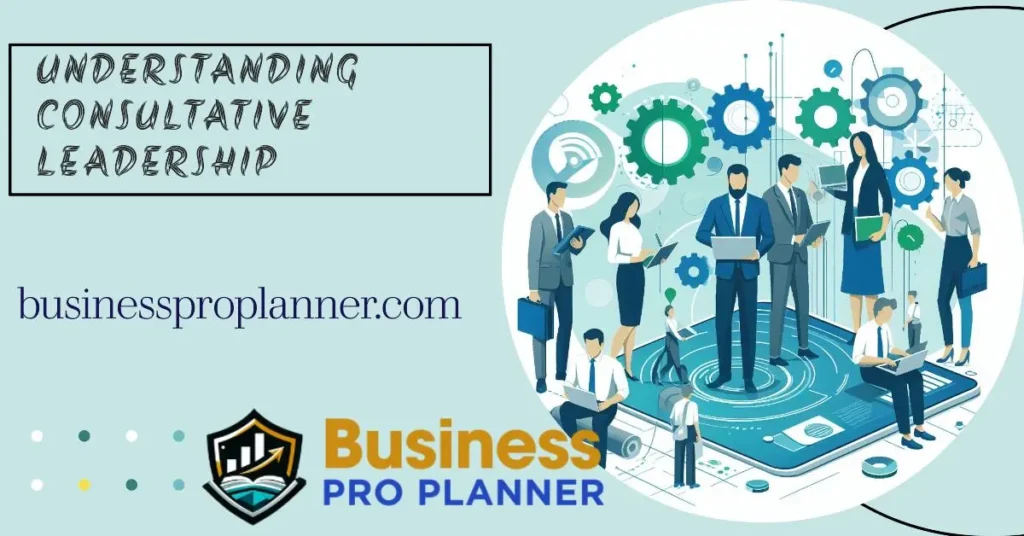In the ever-evolving landscape of business, effective leadership stands as a cornerstone for organizational triumph. As collaboration among teams intensifies, conventional leadership paradigms yield to inclusive methodologies such as consultative leadership. This managerial approach prioritizes transparent communication and collective decision-making, fostering an environment where team members are empowered to share their expertise.
Through the strategic utilization of collective knowledge, consultative leaders drive enhanced decision-making, elevate team morale, and realize successful outcomes. This blog examines consultative leadership’s essentials, benefits, and top practices, guiding readers on maximizing their teams’ potential.
Key Takeaways
- Consultative leadership involves gathering input from team members before making final decisions.
- Leaders employ this style to make informed decisions and get buy-in from their team.
- Some benefits of consultative leadership include increased productivity, employee motivation, and better management of diverse teams.
Understanding Consultative Leadership
Consultative leadership is a leadership style that involves gathering ideas and input from team members before making final decisions. As a consultative leader, you value the opinions and viewpoints of your colleagues and make decisions through an inclusive process.

How it Works
The consultative leadership process typically includes the following steps:
- Defining the issue or goal that needs to be addressed
- Gathering relevant information and viewpoints from team members
- Discussing different options and perspectives with the team
- Weighing the pros and cons of alternatives
- Making the final decision while considering team feedback
- Informing the team of the decision and next steps
- Encouraging ongoing feedback and check-ins along the way
A consultative leader seeks input from team members before making decisions, ensuring well-informed choices. Though retaining final authority, the process remains highly collaborative.
Essential Characteristics of a Successful Consultative Leader
To excel as a consultative leader, it’s imperative to embody essential traits and characteristics:
- Open Communication: Fostering open communication among team members, establishing a culture that promotes sharing ideas, concerns, and perspectives in a comfortable environment.
- Active Listening: Engaging in active listening, dedicating full attention to team members, and displaying authentic interest in their contributions.
- Facilitation Skills: Demonstrating proficiency in facilitating discussions, steering the decision-making process, and ensuring inclusivity by acknowledging all perspectives.
- Trust and Empowerment: Developing strong trust and empowerment among team members, leading to a sense of ownership and value within the team.
- Decisiveness: While embracing collaboration, maintaining the capacity to make difficult decisions and assume accountability for the ultimate results.
Comparing Consultative Leadership to Other Styles
Consultative leadership stands apart from other prevalent styles due to its distinct approach to decision-making and active engagement of team members.
Autocratic Leadership
Under autocratic leadership, decisions are unilaterally made by the leader, typically with minimal input from others, and discussions or collaborations are limited.
Democratic Leadership
Democratic or participative leadership prioritizes consensus-driven decision-making, where the leader fosters discussions but final decisions are made collectively by the team.
Consultative vs. Democratic
In contrast to democratic leadership, consultative leaders maintain the prerogative for final decisions. They incorporate various perspectives to inform their choices, rather than solely entrusting decision-making to others.
Components of Consultative Leadership
The consultative leadership style comprises several pivotal elements that synergize to foster a collaborative and empowering atmosphere:
Gathering Information and Input
Consultative leaders actively engage with team members to gather insights through various channels like individual discussions, group meetings, and surveys. The objective is to grasp diverse viewpoints and harness the team’s collective wisdom and skills.
Fostering Open Communication
Transparent communication forms the foundation of consultative leadership. Leaders cultivate an atmosphere where team members freely share views and ideas, fostering trust and encouraging active involvement in decisions.
Open Communication Practices
| Practice | Description |
|---|---|
| Regular Check-ins | Schedule regular one-on-one meetings to stay connected with team members. |
| Active Listening | Give your full attention and demonstrate interest in team members’ input. |
| Respectful Dialogue | Foster an environment where diverse perspectives are respected and valued. |
| Transparency | Be transparent about decisions, challenges, and organizational developments. |
Facilitating Decision-Making Processes
Consultative leaders facilitate decision-making, valuing input from all team members. Various techniques, such as brainstorming, ensure informed choices reflecting collective wisdom.
Balancing Collaboration and Authority
While consultative leaders prioritize team input, they maintain final decision-making authority, ensuring a balance between collaboration and decisiveness, while assuming responsibility for the ultimate choice.
Benefits of Consultative Leadership
Employing a consultative leadership style offers a multitude of advantages for leaders and their teams alike:
- Increased Productivity: By engaging team members in the decision-making process, consultative leaders instill a sense of empowerment and accountability among employees. This heightened ownership frequently results in enhanced productivity and performance.
- Improved Team Morale: When team members feel heard, valued, and empowered, it can significantly boost morale, job satisfaction, and overall engagement. He recognizes individual contributions and makes people feel valued.
- Enhanced Decision-Making: Gathering diverse viewpoints helps leaders make well-rounded choices based on different experiences and areas of expertise within the team. Decisions are less likely to miss key factors.
- Better Management of Diverse Groups: Consultative leadership is well-suited for managing diverse teams with varying skills, backgrounds, and experiences. By fostering open communication and collaboration, leaders can better leverage the strengths of their diverse teams.
- Stronger Buy-In: Allowing input into major decisions fosters a sense of participation that gets buy-in when the final call is made. Teams are more likely to support and implement choices they helped shape.
- Skill Development: Through collaborative processes, both leaders and team members can develop their leadership, decision-making, and communication skills.
Implementing Consultative Leadership
Transitioning to a consultative leadership style requires a concerted effort and the development of specific skills:
Becoming an Effective Consultative Leader
To implement consultative leadership successfully, focus on cultivating specific competencies and behaviors. Here are some key recommendations:
- Get to Know Your Team: Really understand each person’s expertise, talents, preferred communication, and decision-making styles. Tailor your approach accordingly.
- Solicit Input Upfront: Rather than informing people of choices already made, engage staff proactively in planning and assessments to shape direction.
- Actively Listen: Give full attention when others are speaking without distraction. Paraphrase back to show you understand various positions clearly.
- Weigh Options Objectively: Thoroughly assess the pros and cons of alternatives without biases toward your initial stance. Adjust perceptions in light of team views.
- Communicate Rationale: When announcing final choices, explain influences like data, priorities, and perspectives that carried the most weight in your analysis.
- Check Progress Regularly: Maintain ongoing discussions as projects unfold. Adjust tactics if needed based on feedback about execution and morale.
- Lead by Example: Model consultation in your own thinking so others learn. Share dilemmas you face to foster a culture where advice is valued up and down.
Creating a Culture of Trust and Open Dialogue
Nurturing trust and facilitating open communication are fundamental elements of consultative leadership. Leaders can accomplish this by:
- Leading by example and demonstrating transparency in their own communication and decision-making processes.
- Actively seeking input from team members and genuinely considering their perspectives.
- Acknowledging and valuing the contributions of team members, making them feel heard and respected.
- Promoting constructive discussions and establishing an inclusive environment where diverse viewpoints are welcomed and respected.
Consultative Leadership in Practice
Integrating consultative leadership can manifest diversely, tailored to individual organizational and team requisites. Below are real-life instances and case analyses exemplifying the practical application of consultative leadership principles.
Consultative Leadership Case Studies
| Organization | Example |
|---|---|
| Software Development Company | The CEO of a software development firm implemented a consultative leadership approach to improve decision-making processes and leverage the collective expertise of the team. Regular team meetings, brainstorming sessions, and open communication channels allowed team members to contribute their ideas and perspectives, leading to better product decisions and increased team engagement. |
| Healthcare Facility | A hospital executive adopted a consultative leadership style to address challenges in patient care and staff morale. By involving healthcare professionals, nurses, and support staff in decision-making processes, the executive was able to make more informed decisions that considered the diverse perspectives of those on the front lines. This approach led to improved patient outcomes and increased job satisfaction among staff. |
| Global Retail Brand | A global retail brand’s CEO implemented consultative leadership practices to better understand the needs and preferences of customers in different regions. By gathering input from regional managers, store employees, and customer feedback channels, the CEO and leadership team could make more localized and customer-centric decisions, leading to increased sales and customer loyalty. |
Addressing Challenges and Limitations
Although consultative leadership provides many advantages, it’s crucial to acknowledge potential obstacles and constraints.
- Time-Consuming Processes: Collecting feedback and engaging team members in the decision-making process can be a time-intensive endeavor, particularly within sizable corporations or high-speed work settings.
- Resistance to Change: Some team members may be resistant to the shift towards a more collaborative leadership style, preferring clear direction from a decisive leader.
- Indecisiveness: If not balanced properly, the emphasis on collaboration and input can lead to indecisiveness or prolonged decision-making processes.
To address these challenges, consultative leaders should aim to streamline processes where possible, provide clear communication about the benefits of collaboration, and ensure that they maintain decisiveness when necessary.
Consultative Leadership in Action
To put this style into practice, here are tips for three common workplace scenarios where consultation is key:
- Business Planning: Hold brainstorming sessions to gather frontline perspectives on goals, objectives, performance targets, obstacles, and strategies for the next year.
- New Project Launch: Convene the implementation team to jointly craft timelines, assign roles, hurdles to prioritize, and ideas for ensuring success metrics are met.
- Performance Reviews: Rather than solely assessing employees, facilitate two-way conversations to solicit self-evaluations along with suggestions for goals, training needs, and future growth.

Conclusion
Consultative leadership, a potent management methodology, harnesses teams’ collective wisdom for well-informed decisions. Through nurturing transparent communication, fostering trust, and empowering team participation, consultative leaders foster heightened productivity, bolstered team morale, and refined decision-making frameworks.
Embracing this leadership style necessitates adept facilitation and communication prowess, the artful balance of collaboration and decisiveness, and an unwavering commitment to cultivating a culture of trust and empowerment.
By espousing consultative leadership tenets, leaders unlock team potential, adeptly navigate diverse team dynamics, and propel organizational triumph via collaborative and informed decision-making processes.

